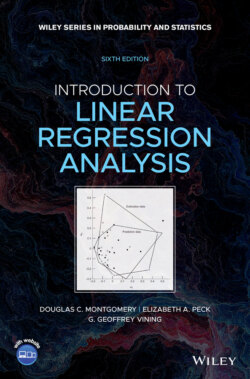Читать книгу Introduction to Linear Regression Analysis - Douglas C. Montgomery - Страница 51
Example 2.8 The Shelf-Stocking Data
ОглавлениеThe time required for a merchandiser to stock a grocery store shelf with a soft drink product as well as the number of cases of product stocked is shown in Table 2.10. The scatter diagram shown in Figure 2.14 suggests that a straight line passing through the origin could be used to express the relationship between time and the number of cases stocked. Furthermore, since if the number of cases x = 0, then shelf stocking time y = 0, this model seems intuitively reasonable. Note also that the range of x is close to the origin.
The slope in the no-intercept model is computed from Eq. (2.50) as
Therefore, the fitted equation is
This regression line is shown in Figure 2.15. The residual mean square for this model is MSRes = 0.0893 and . Furthermore, the t statistic for testing H0: β1 = 0 is t0 = 91.13, for which the P value is 8.02 × 10−21. These summary statistics do not reveal any startling inadequacy in the no-intercept model.
We may also fit the intercept model to the data for comparative purposes. This results in
The t statistic for testing H0: β0 = 0 is t0 = −0.65, which is not significant, implying that the no-intercept model may provide a superior fit. The residual mean square for the intercept model is MSRes = 0.0931 and R2 = 0.9997. Since MSRes for the no-intercept model is smaller than MSRes for the intercept model, we conclude that the no-intercept model is superior. As noted previously, the R2 statistics are not directly comparable.
TABLE 2.10 Shelf-Stocking Data for Example 2.8
| Times, y (minutes) | Cases Stocked, x |
| 10.15 | 25 |
| 2.96 | 6 |
| 3.00 | 8 |
| 6.88 | 17 |
| 0.28 | 2 |
| 5.06 | 13 |
| 9.14 | 23 |
| 11.86 | 30 |
| 11.69 | 28 |
| 6.04 | 14 |
| 7.57 | 19 |
| 1.74 | 4 |
| 9.38 | 24 |
| 0.16 | 1 |
| 1.84 | 5 |
Figure 2.14 Scatter diagram of shelf-stocking data.
Figure 2.15 The confidence and prediction bands for the shelf-stocing data.
Figure 2.15 also shows the 95% confidence interval or E(y|x0) computed from Eq. (2.54) and the 95% prediction interval on a single future observation y0 at x = x0 computed from Eq. (2.55). Notice that the length of the confidence interval at x0 = 0 is zero.
SAS handles the no-intercept case. For this situation, the model statement follows:
model time = cases/noint
